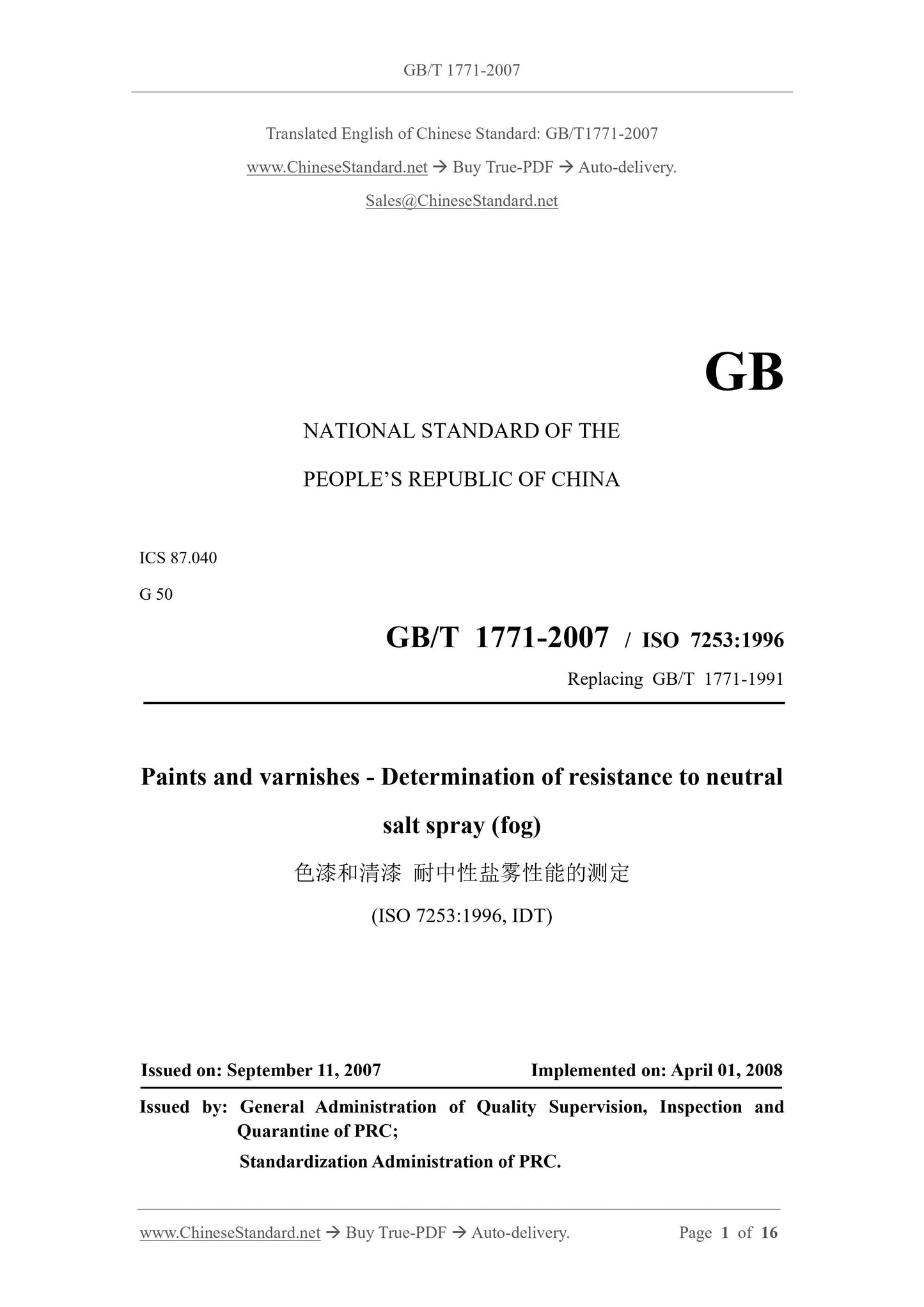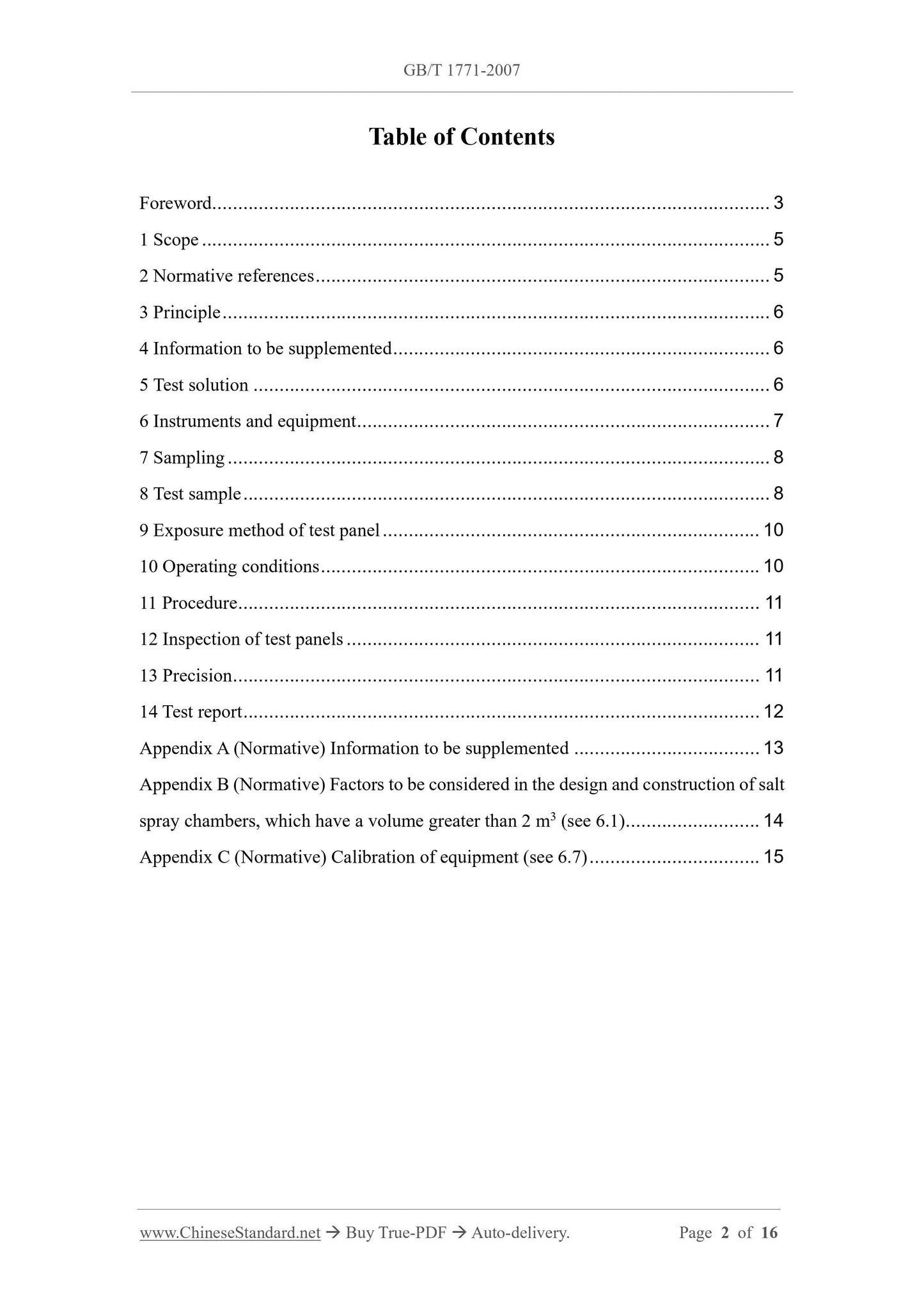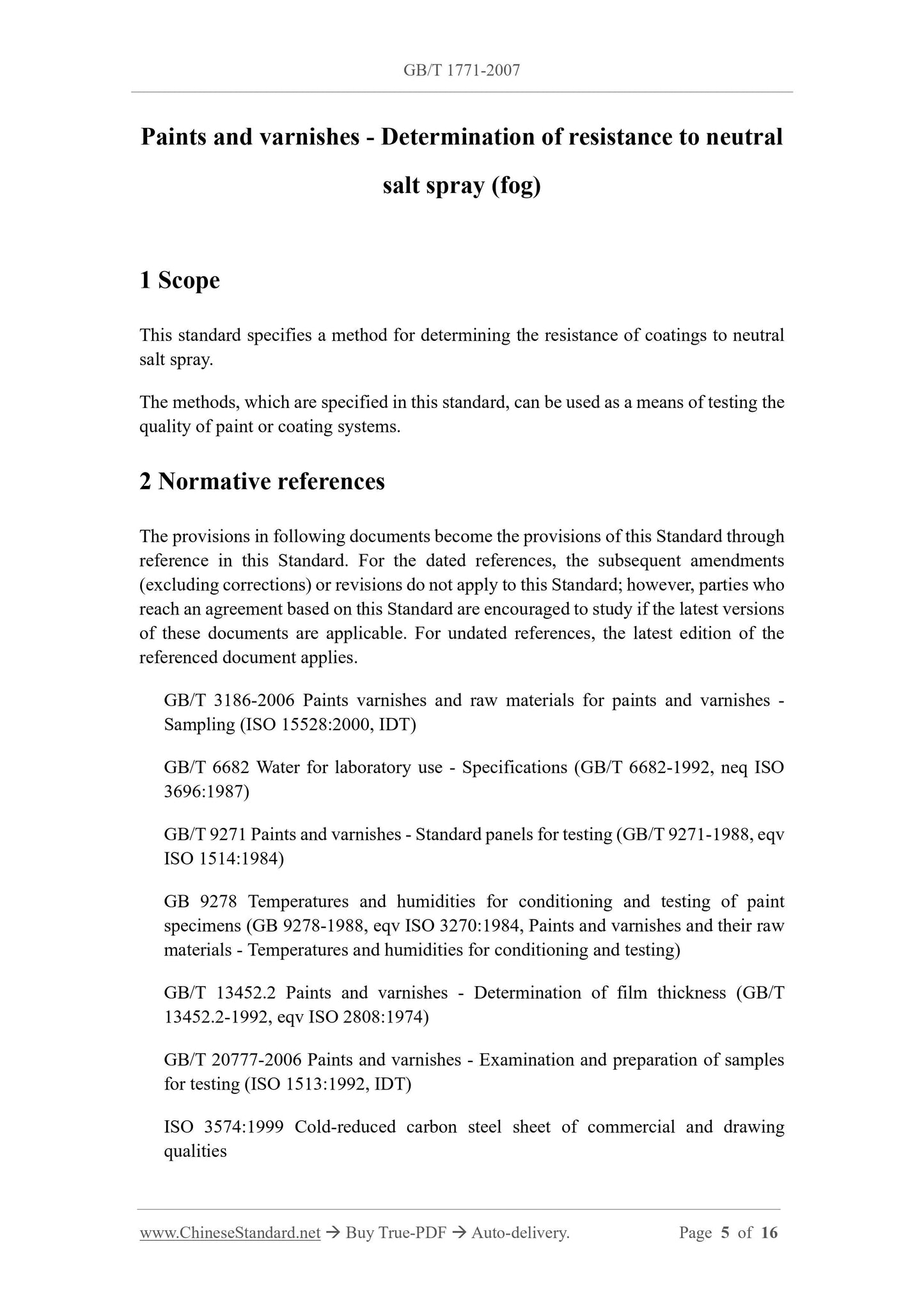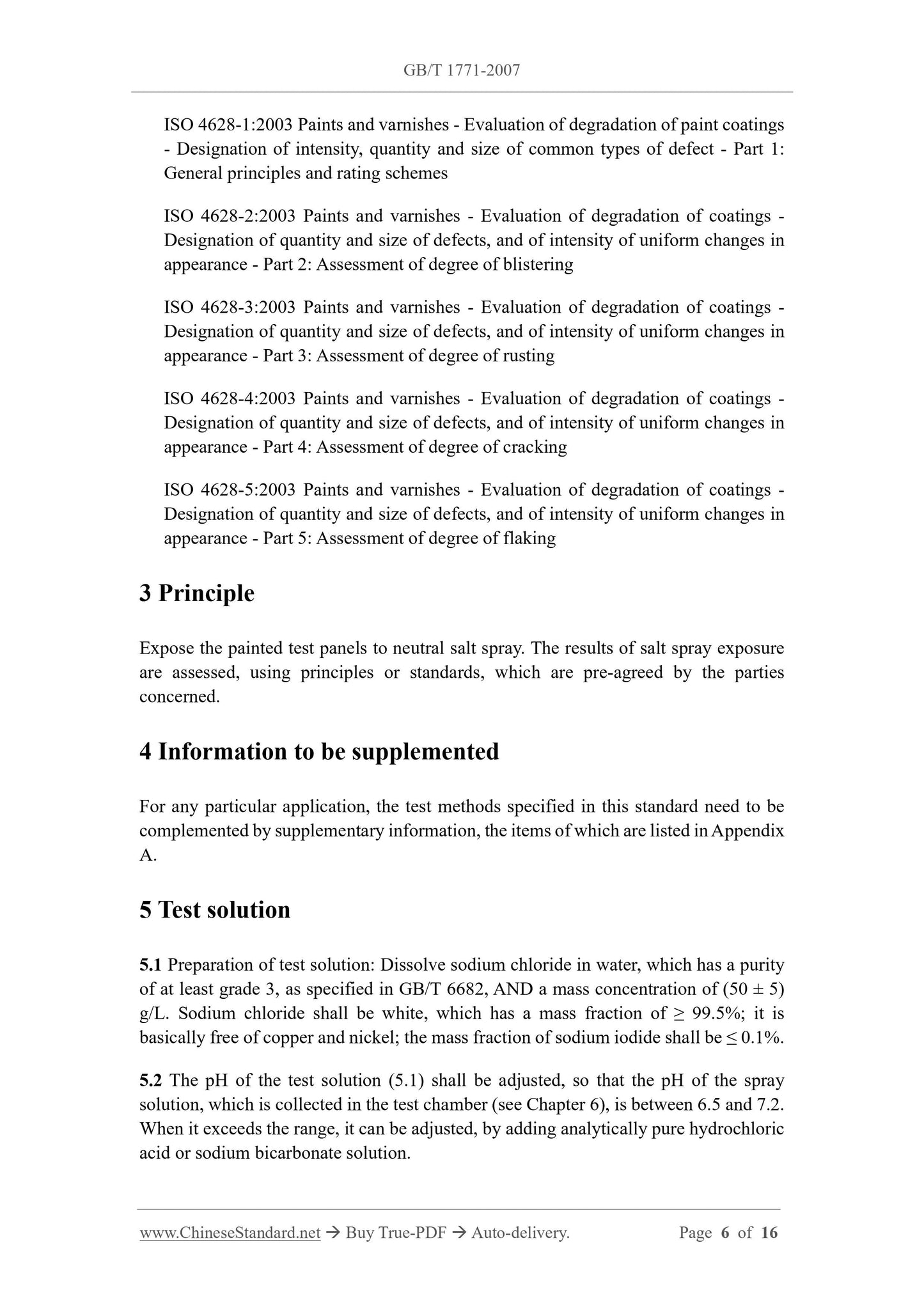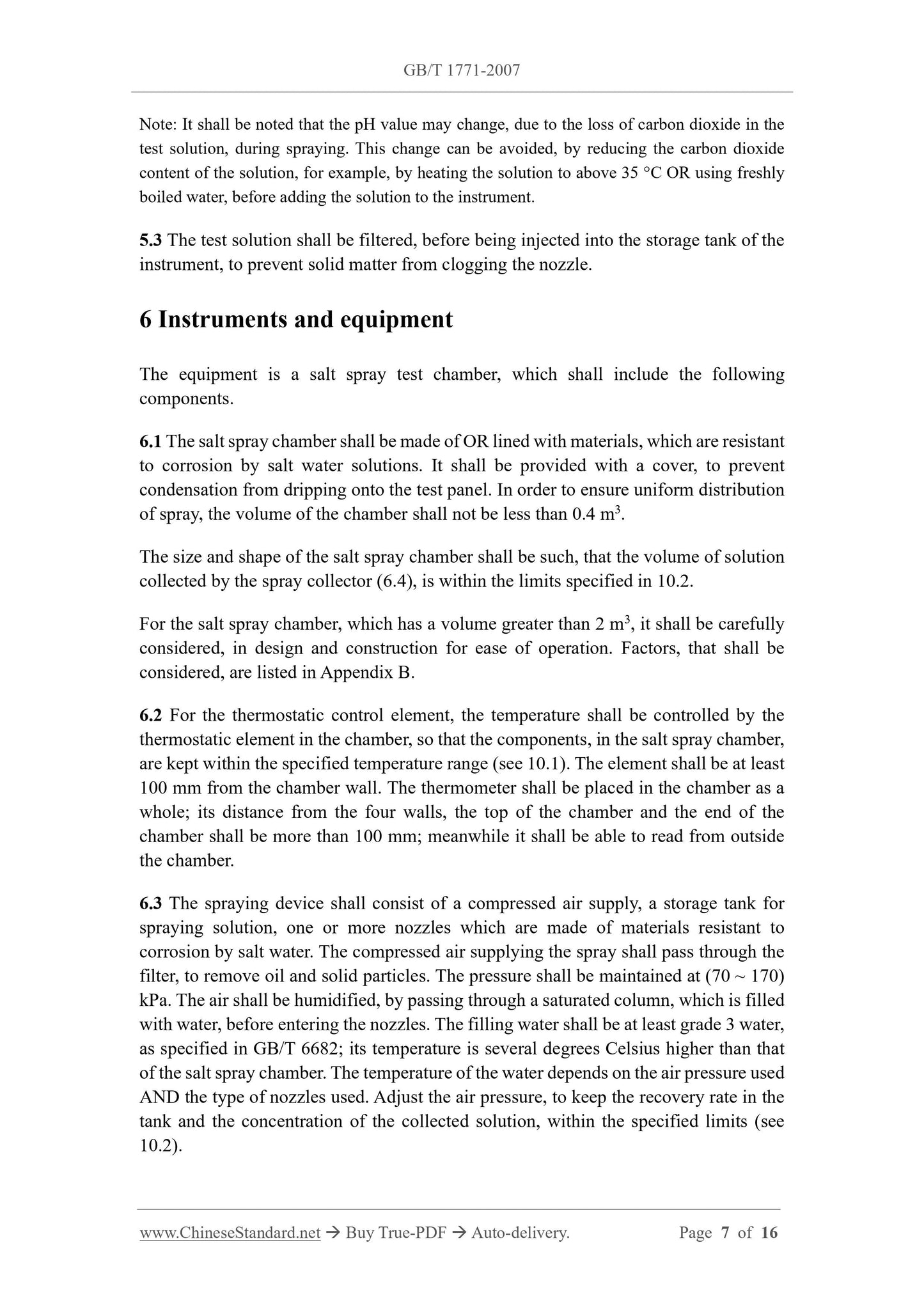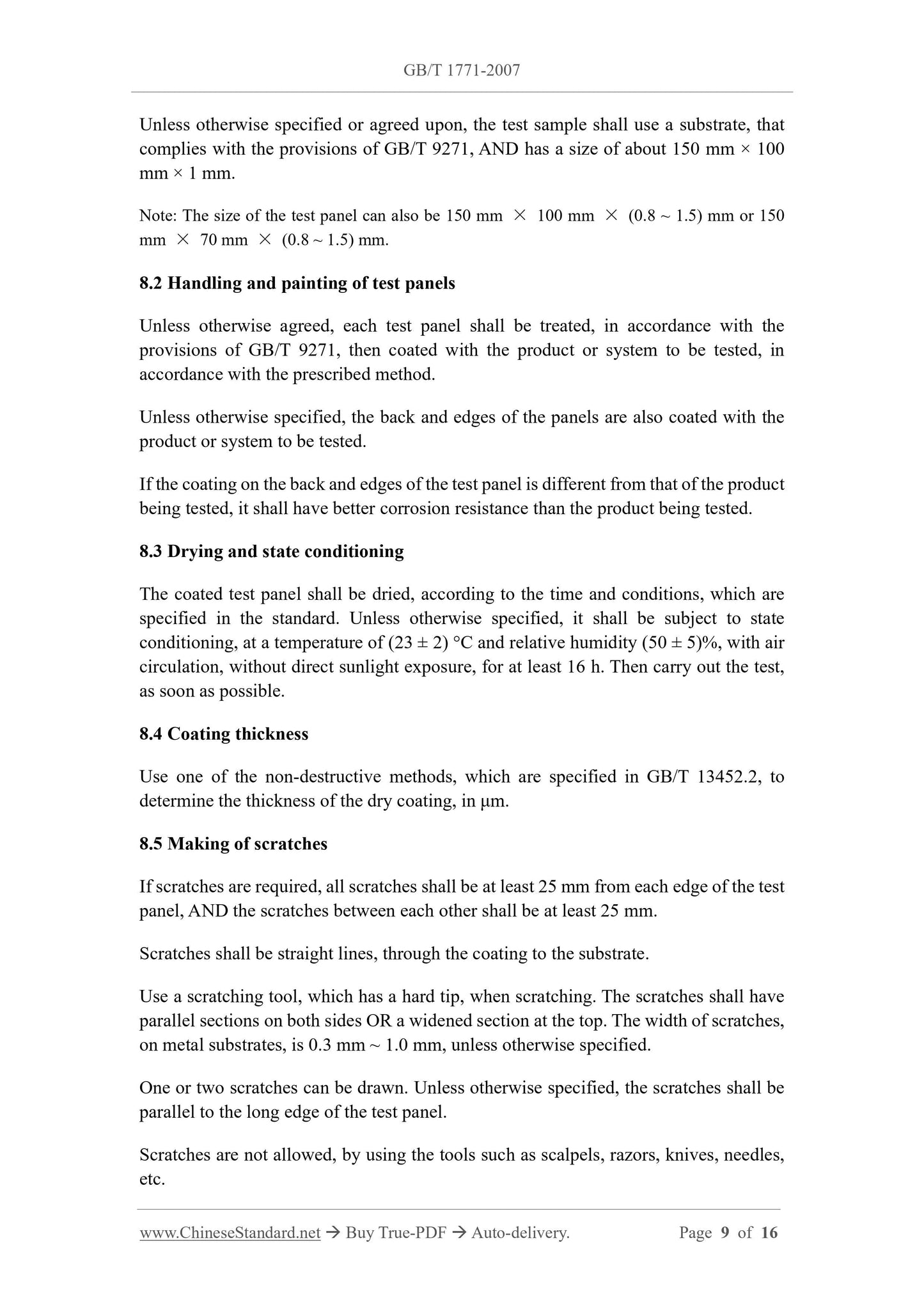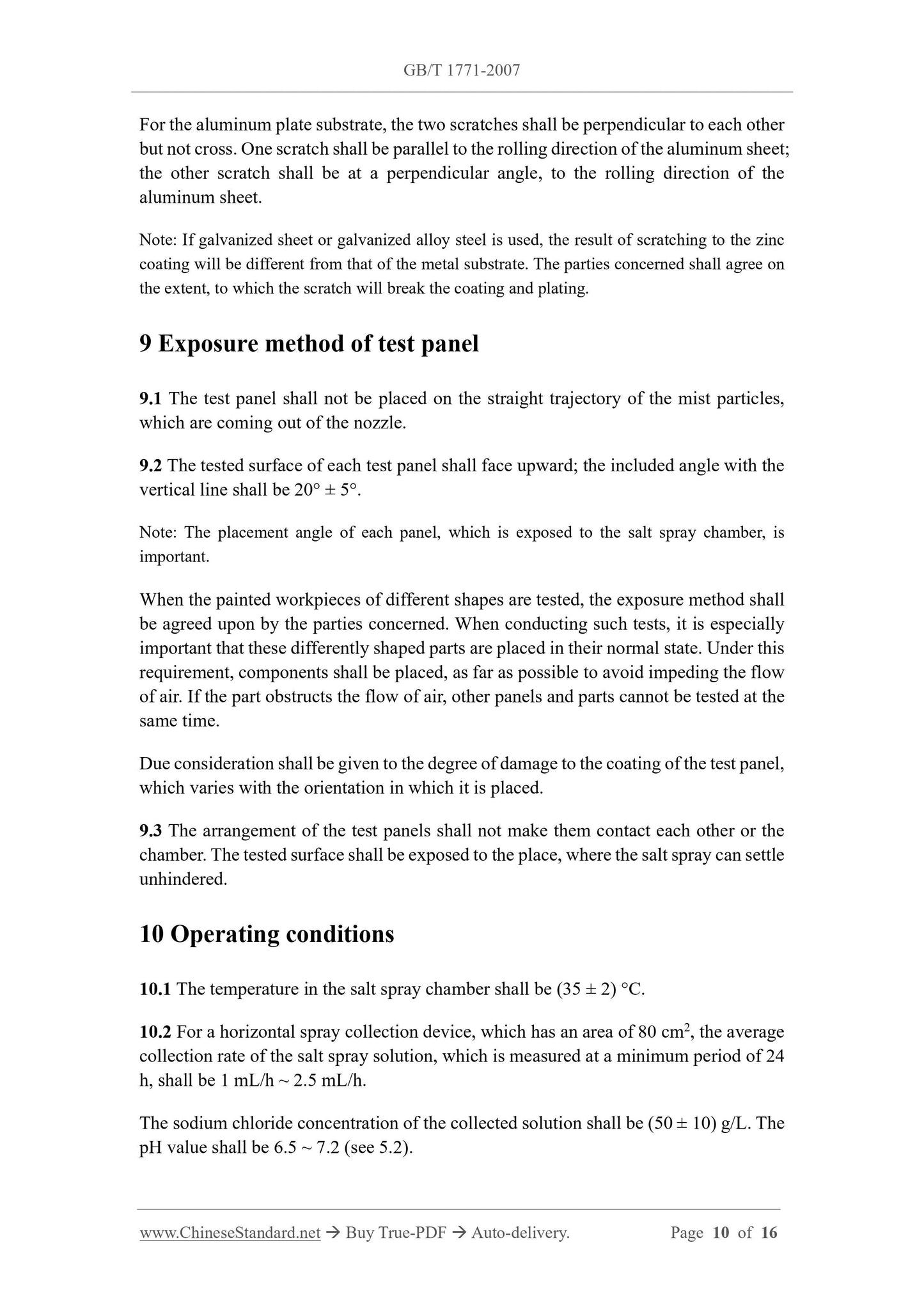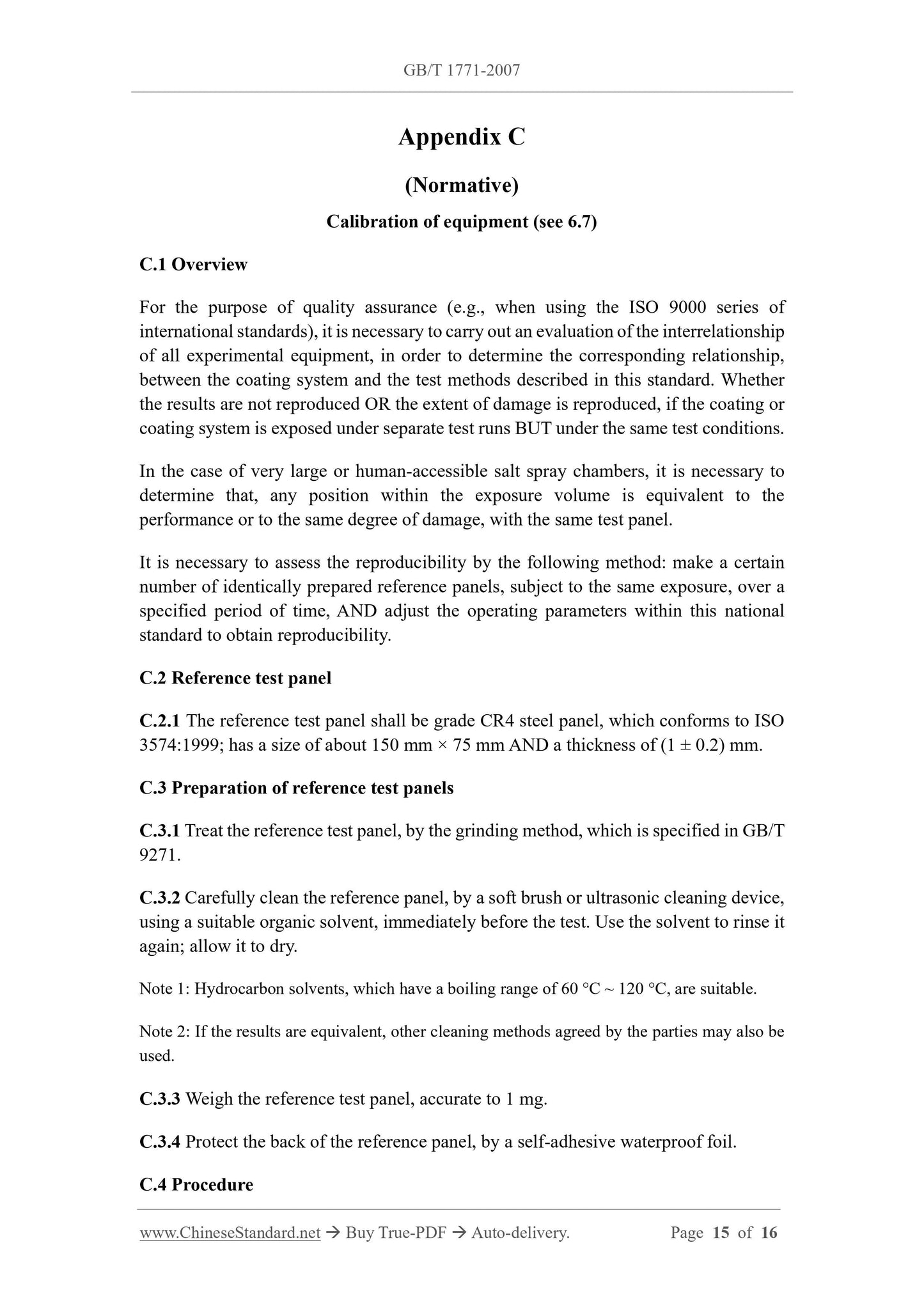1
/
of
8
PayPal, credit cards. Download editable-PDF and invoice in 1 second!
GB/T 1771-2007 English PDF (GBT1771-2007)
GB/T 1771-2007 English PDF (GBT1771-2007)
Regular price
$125.00 USD
Regular price
Sale price
$125.00 USD
Unit price
/
per
Shipping calculated at checkout.
Couldn't load pickup availability
Delivery: 3 seconds. Download true-PDF + Invoice.
Get QUOTATION in 1-minute: Click GB/T 1771-2007
Historical versions: GB/T 1771-2007
Preview True-PDF (Reload/Scroll if blank)
GB/T 1771-2007: Paints and Varnishes -- Determination of resistance to neutral salt spray (fog)
GB/T 1771-2007
NATIONAL STANDARD OF THE
PEOPLE’S REPUBLIC OF CHINA
ICS 87.040
G 50
GB/T 1771-2007 / ISO 7253:1996
Replacing GB/T 1771-1991
Paints and varnishes - Determination of resistance to neutral
salt spray (fog)
(ISO 7253:1996, IDT)
ISSUED ON: SEPTEMBER 11, 2007
IMPLEMENTED ON: APRIL 01, 2008
Issued by: General Administration of Quality Supervision, Inspection and
Quarantine of PRC;
Standardization Administration of PRC.
Table of Contents
Foreword ... 3
1 Scope ... 5
2 Normative references ... 5
3 Principle ... 6
4 Information to be supplemented ... 6
5 Test solution ... 6
6 Instruments and equipment ... 7
7 Sampling ... 8
8 Test sample ... 8
9 Exposure method of test panel ... 10
10 Operating conditions ... 10
11 Procedure ... 11
12 Inspection of test panels ... 11
13 Precision ... 11
14 Test report ... 12
Appendix A (Normative) Information to be supplemented ... 13
Appendix B (Normative) Factors to be considered in the design and construction of salt
spray chambers, which have a volume greater than 2 m3 (see 6.1) ... 14
Appendix C (Normative) Calibration of equipment (see 6.7) ... 15
Paints and varnishes - Determination of resistance to neutral
salt spray (fog)
1 Scope
This standard specifies a method for determining the resistance of coatings to neutral
salt spray.
The methods, which are specified in this standard, can be used as a means of testing the
quality of paint or coating systems.
2 Normative references
The provisions in following documents become the provisions of this Standard through
reference in this Standard. For the dated references, the subsequent amendments
(excluding corrections) or revisions do not apply to this Standard; however, parties who
reach an agreement based on this Standard are encouraged to study if the latest versions
of these documents are applicable. For undated references, the latest edition of the
referenced document applies.
GB/T 3186-2006 Paints varnishes and raw materials for paints and varnishes -
Sampling (ISO 15528:2000, IDT)
GB/T 6682 Water for laboratory use - Specifications (GB/T 6682-1992, neq ISO
3696:1987)
GB/T 9271 Paints and varnishes - Standard panels for testing (GB/T 9271-1988, eqv
ISO 1514:1984)
GB 9278 Temperatures and humidities for conditioning and testing of paint
specimens (GB 9278-1988, eqv ISO 3270:1984, Paints and varnishes and their raw
materials - Temperatures and humidities for conditioning and testing)
GB/T 13452.2 Paints and varnishes - Determination of film thickness (GB/T
13452.2-1992, eqv ISO 2808:1974)
GB/T 20777-2006 Paints and varnishes - Examination and preparation of samples
for testing (ISO 1513:1992, IDT)
ISO 3574:1999 Cold-reduced carbon steel sheet of commercial and drawing
qualities
ISO 4628-1:2003 Paints and varnishes - Evaluation of degradation of paint coatings
- Designation of intensity, quantity and size of common types of defect - Part 1:
General principles and rating schemes
ISO 4628-2:2003 Paints and varnishes - Evaluation of degradation of coatings -
Designation of quantity and size of defects, and of intensity of uniform changes in
appearance - Part 2: Assessment of degree of blistering
ISO 4628-3:2003 Paints and varnishes - Evaluation of degradation of coatings -
Designation of quantity and size of defects, and of intensity of uniform changes in
appearance - Part 3: Assessment of degree of rusting
ISO 4628-4:2003 Paints and varnishes - Evaluation of degradation of coatings -
Designation of quantity and size of defects, and of intensity of uniform changes in
appearance - Part 4: Assessment of degree of cracking
ISO 4628-5:2003 Paints and varnishes - Evaluation of degradation of coatings -
Designation of quantity and size of defects, and of intensity of uniform changes in
appearance - Part 5: Assessment of degree of flaking
3 Principle
Expose the painted test panels to neutral salt spray. The results of salt spray exposure
are assessed, using principles or standards, which are pre-agreed by the parties
concerned.
4 Information to be supplemented
For any particular application, the test methods specified in this standard need to be
complemented by supplementary information, the items of which are listed in Appendix
A.
5 Test solution
5.1 Preparation of test solution: Dissolve sodium chloride in water, which has a purity
of at least grade 3, as specified in GB/T 6682, AND a mass concentration of (50 ± 5)
g/L. Sodium chloride shall be white, which has a mass fraction of ≥ 99.5%; it is
basically free of copper and nickel; the mass fraction of sodium iodide shall be ≤ 0.1%.
5.2 The pH of the test solution (5.1) shall be adjusted, so that the pH of the spray
solution, which is collected in the test chamber (see Chapter 6), is between 6.5 and 7.2.
When it exceeds the range, it can be adjusted, by adding analytically pure hydrochloric
acid or sodium bicarbonate solution.
Note: It shall be noted that the pH value may change, due to the loss of carbon dioxide in the
test solution, during spraying. This change can be avoided, by reducing the carbon dioxide
content of the solution, for example, by heating the solution to above 35 °C OR using freshly
boiled water, before adding the solution to the instrument.
5.3 The test solution shall be filtered, before being injected into the storage tank of the
instrument, to prevent solid matter from clogging the nozzle.
6 Instruments and equipment
The equipment is a salt spray test chamber, which shall include the following
components.
6.1 The salt spray chamber shall be made of OR lined with materials, which are resistant
to corrosion by salt water solutions. It shall be provided with a cover, to prevent
condensation from dripping onto the test panel. In order to ensure uniform distribution
of spray, the volume of the chamber shall not be less than 0.4 m3.
The size and shape of the salt spray chamber shall be such, that the volume of solution
collected by the spray collector (6.4), is within the limits specified in 10.2.
For the salt spray chamber, which has a volume greater than 2 m3, it shall be carefully
considered, in design and construction for ease of operation. Factors, that shall be
considered, are listed in Appendix B.
6.2 For the thermostatic control element, the temperature shall be controlled by the
thermostatic element in the chamber, so that the components, in the salt spray chamber,
are kept within the specified temperature range (see 10.1). The element shall be at least
100 mm from the chamber wall. The thermometer shall be placed in the chamber as a
whole; its distance from the four walls, the top of the chamber and the end of the
chamber shall be more than 100 mm; meanwhile it shall be able to read from outside
the chamber.
6.3 The spraying device shall consist of a compressed air supply, a storage tank for
spraying solution, one or more nozzles which are made of materials resistant to
corrosion by salt water. The compressed air supplying the spray shall pass through the
filter, to remove oil and solid particles. The pressure shall be maintained at (70 ~ 170)
kPa. The air shall be humidified, by passing through a saturated column, which is filled
with water, before entering the nozzles. The filling water shall be at least grade 3 water,
as specified in GB/T 6682; its temperature is several degrees Celsius higher than that
of the salt spray chamber. The temperatur...
Get QUOTATION in 1-minute: Click GB/T 1771-2007
Historical versions: GB/T 1771-2007
Preview True-PDF (Reload/Scroll if blank)
GB/T 1771-2007: Paints and Varnishes -- Determination of resistance to neutral salt spray (fog)
GB/T 1771-2007
NATIONAL STANDARD OF THE
PEOPLE’S REPUBLIC OF CHINA
ICS 87.040
G 50
GB/T 1771-2007 / ISO 7253:1996
Replacing GB/T 1771-1991
Paints and varnishes - Determination of resistance to neutral
salt spray (fog)
(ISO 7253:1996, IDT)
ISSUED ON: SEPTEMBER 11, 2007
IMPLEMENTED ON: APRIL 01, 2008
Issued by: General Administration of Quality Supervision, Inspection and
Quarantine of PRC;
Standardization Administration of PRC.
Table of Contents
Foreword ... 3
1 Scope ... 5
2 Normative references ... 5
3 Principle ... 6
4 Information to be supplemented ... 6
5 Test solution ... 6
6 Instruments and equipment ... 7
7 Sampling ... 8
8 Test sample ... 8
9 Exposure method of test panel ... 10
10 Operating conditions ... 10
11 Procedure ... 11
12 Inspection of test panels ... 11
13 Precision ... 11
14 Test report ... 12
Appendix A (Normative) Information to be supplemented ... 13
Appendix B (Normative) Factors to be considered in the design and construction of salt
spray chambers, which have a volume greater than 2 m3 (see 6.1) ... 14
Appendix C (Normative) Calibration of equipment (see 6.7) ... 15
Paints and varnishes - Determination of resistance to neutral
salt spray (fog)
1 Scope
This standard specifies a method for determining the resistance of coatings to neutral
salt spray.
The methods, which are specified in this standard, can be used as a means of testing the
quality of paint or coating systems.
2 Normative references
The provisions in following documents become the provisions of this Standard through
reference in this Standard. For the dated references, the subsequent amendments
(excluding corrections) or revisions do not apply to this Standard; however, parties who
reach an agreement based on this Standard are encouraged to study if the latest versions
of these documents are applicable. For undated references, the latest edition of the
referenced document applies.
GB/T 3186-2006 Paints varnishes and raw materials for paints and varnishes -
Sampling (ISO 15528:2000, IDT)
GB/T 6682 Water for laboratory use - Specifications (GB/T 6682-1992, neq ISO
3696:1987)
GB/T 9271 Paints and varnishes - Standard panels for testing (GB/T 9271-1988, eqv
ISO 1514:1984)
GB 9278 Temperatures and humidities for conditioning and testing of paint
specimens (GB 9278-1988, eqv ISO 3270:1984, Paints and varnishes and their raw
materials - Temperatures and humidities for conditioning and testing)
GB/T 13452.2 Paints and varnishes - Determination of film thickness (GB/T
13452.2-1992, eqv ISO 2808:1974)
GB/T 20777-2006 Paints and varnishes - Examination and preparation of samples
for testing (ISO 1513:1992, IDT)
ISO 3574:1999 Cold-reduced carbon steel sheet of commercial and drawing
qualities
ISO 4628-1:2003 Paints and varnishes - Evaluation of degradation of paint coatings
- Designation of intensity, quantity and size of common types of defect - Part 1:
General principles and rating schemes
ISO 4628-2:2003 Paints and varnishes - Evaluation of degradation of coatings -
Designation of quantity and size of defects, and of intensity of uniform changes in
appearance - Part 2: Assessment of degree of blistering
ISO 4628-3:2003 Paints and varnishes - Evaluation of degradation of coatings -
Designation of quantity and size of defects, and of intensity of uniform changes in
appearance - Part 3: Assessment of degree of rusting
ISO 4628-4:2003 Paints and varnishes - Evaluation of degradation of coatings -
Designation of quantity and size of defects, and of intensity of uniform changes in
appearance - Part 4: Assessment of degree of cracking
ISO 4628-5:2003 Paints and varnishes - Evaluation of degradation of coatings -
Designation of quantity and size of defects, and of intensity of uniform changes in
appearance - Part 5: Assessment of degree of flaking
3 Principle
Expose the painted test panels to neutral salt spray. The results of salt spray exposure
are assessed, using principles or standards, which are pre-agreed by the parties
concerned.
4 Information to be supplemented
For any particular application, the test methods specified in this standard need to be
complemented by supplementary information, the items of which are listed in Appendix
A.
5 Test solution
5.1 Preparation of test solution: Dissolve sodium chloride in water, which has a purity
of at least grade 3, as specified in GB/T 6682, AND a mass concentration of (50 ± 5)
g/L. Sodium chloride shall be white, which has a mass fraction of ≥ 99.5%; it is
basically free of copper and nickel; the mass fraction of sodium iodide shall be ≤ 0.1%.
5.2 The pH of the test solution (5.1) shall be adjusted, so that the pH of the spray
solution, which is collected in the test chamber (see Chapter 6), is between 6.5 and 7.2.
When it exceeds the range, it can be adjusted, by adding analytically pure hydrochloric
acid or sodium bicarbonate solution.
Note: It shall be noted that the pH value may change, due to the loss of carbon dioxide in the
test solution, during spraying. This change can be avoided, by reducing the carbon dioxide
content of the solution, for example, by heating the solution to above 35 °C OR using freshly
boiled water, before adding the solution to the instrument.
5.3 The test solution shall be filtered, before being injected into the storage tank of the
instrument, to prevent solid matter from clogging the nozzle.
6 Instruments and equipment
The equipment is a salt spray test chamber, which shall include the following
components.
6.1 The salt spray chamber shall be made of OR lined with materials, which are resistant
to corrosion by salt water solutions. It shall be provided with a cover, to prevent
condensation from dripping onto the test panel. In order to ensure uniform distribution
of spray, the volume of the chamber shall not be less than 0.4 m3.
The size and shape of the salt spray chamber shall be such, that the volume of solution
collected by the spray collector (6.4), is within the limits specified in 10.2.
For the salt spray chamber, which has a volume greater than 2 m3, it shall be carefully
considered, in design and construction for ease of operation. Factors, that shall be
considered, are listed in Appendix B.
6.2 For the thermostatic control element, the temperature shall be controlled by the
thermostatic element in the chamber, so that the components, in the salt spray chamber,
are kept within the specified temperature range (see 10.1). The element shall be at least
100 mm from the chamber wall. The thermometer shall be placed in the chamber as a
whole; its distance from the four walls, the top of the chamber and the end of the
chamber shall be more than 100 mm; meanwhile it shall be able to read from outside
the chamber.
6.3 The spraying device shall consist of a compressed air supply, a storage tank for
spraying solution, one or more nozzles which are made of materials resistant to
corrosion by salt water. The compressed air supplying the spray shall pass through the
filter, to remove oil and solid particles. The pressure shall be maintained at (70 ~ 170)
kPa. The air shall be humidified, by passing through a saturated column, which is filled
with water, before entering the nozzles. The filling water shall be at least grade 3 water,
as specified in GB/T 6682; its temperature is several degrees Celsius higher than that
of the salt spray chamber. The temperatur...
Share
